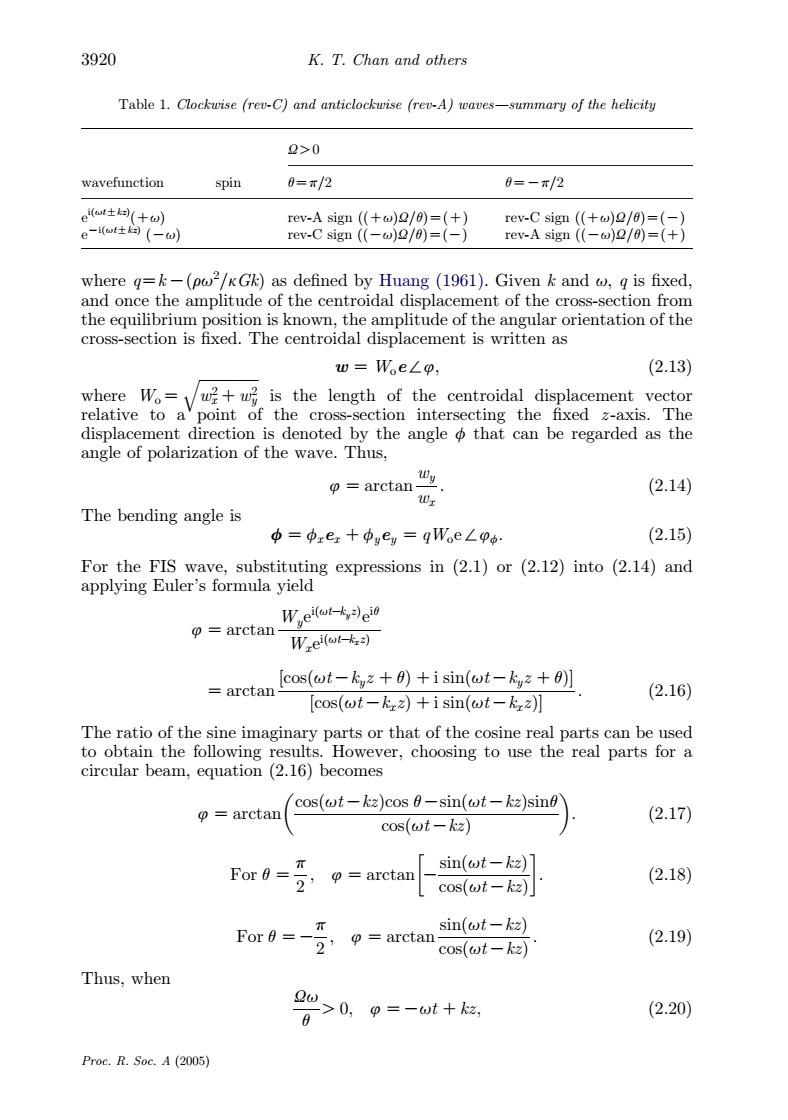正在加载图片...

3920 K.T.Chan and others Table 1.Clockwise (rev-C)and anticlockwise (rev-A)waves-summary of the helicity 2>0 wavefunction spin 0=x/2 0=-x/2 e(a土(+) rev-Asig(+d)2/0)=(+) rev-C sign ((+)/0)=(-) e-iau生a(-)) rev-C sign ((-W)2/0)=(-) rev-A sign ((-@)2/0)=(+) where q=k-(po2/KGk)as defined by Huang (1961).Given k and w,g is fixed, and once the amplitude of the centroidal displacement of the cross-section from the equilibrium position is known,the amplitude of the angular orientation of the cross-section is fixed.The centroidal displacement is written as w=W。e∠p, (2.13) where Wo=w?+w is the length of the centroidal displacement vector relative to a'point of the cross-section intersecting the fixed z-axis.The displacement direction is denoted by the angle o that can be regarded as the angle of polarization of the wave.Thus, arctan- (2.14) r The bending angle is φ=φrer+中geg=qWe∠po: (2.15) For the FIS wave,substituting expressions in (2.1)or (2.12)into (2.14)and applying Euler's formula yield Wiei(ot-k)io o arctan Wei(wt-tz习 [cos(ωt-kgz+)+isin(ωt-kyz+)] arctan (2.16) [cos(ot-k:2)+isin(@t-k:2)] The ratio of the sine imaginary parts or that of the cosine real parts can be used to obtain the following results.However,choosing to use the real parts for a circular beam,equation (2.16)becomes cos(@t-kz)cos 0-sin(wt-kz)sine o arctan (2.17) cos(wt-kz) For0= sin(wt-kz) 2 arctan cos(wt-kz) (2.18) For 0=7 p=arctan sin(wt-kz) (2.19) cos(wt-kz) Thus,when 0>0,p=-wt+k2, (2.20) Proc.R.Soc.A(2005)where qZkK(ru2 /kGk) as defined by Huang (1961). Given k and u, q is fixed, and once the amplitude of the centroidal displacement of the cross-section from the equilibrium position is known, the amplitude of the angular orientation of the cross-section is fixed. The centroidal displacement is written as w Z Woe:4; ð2:13Þ where WoZ ffiffiffiffiffiffiffiffiffiffiffiffiffiffiffiffi w2 x Cw2 y q is the length of the centroidal displacement vector relative to a point of the cross-section intersecting the fixed z -axis. The displacement direction is denoted by the angle f that can be regarded as the angle of polarization of the wave. Thus, 4 Zarctan wy wx : ð2:14Þ The bending angle is f Zfxex Cfyey ZqWoe:4f: ð2:15Þ For the FIS wave, substituting expressions in (2.1) or (2.12) into (2.14) and applying Euler’s formula yield 4 Zarctan WyeiðutKkyzÞ eiq Wx eiðutKkx zÞ Zarctan ½cosðutKkyz CqÞ Ci sinðutKkyz CqÞ ½cosðutKkx zÞ Ci sinðutKkx zÞ : ð2:16Þ The ratio of the sine imaginary parts or that of the cosine real parts can be used to obtain the following results. However, choosing to use the real parts for a circular beam, equation (2.16) becomes 4 Zarctan cosðutKkzÞcos qKsinðutKkzÞsinq cosðutKkzÞ : ð2:17Þ For q Z p 2 ; 4 Zarctan KsinðutKkzÞ cosðutKkzÞ : ð2:18Þ For q ZKp 2 ; 4 Zarctan sinðutKkzÞ cosðutKkzÞ : ð2:19Þ Thus, when Uu q O0; 4 ZKut Ckz; ð2:20Þ Table 1. Clockwise (rev-C) and anticlockwise (rev-A) waves—summary of the helicity wavefunction spin UO0 qZp/2 qZKp/2 e i(utGkz) (Cu) rev-A sign ((Cu)U/q)Z(C) rev-C sign ((Cu)U/q)Z(K) eKi(utGkz) (Ku) rev-C sign ((Ku)U/q)Z(K) rev-A sign ((Ku)U/q)Z(C) 3920 K. T. Chan and others Proc. R. Soc. A (2005)��